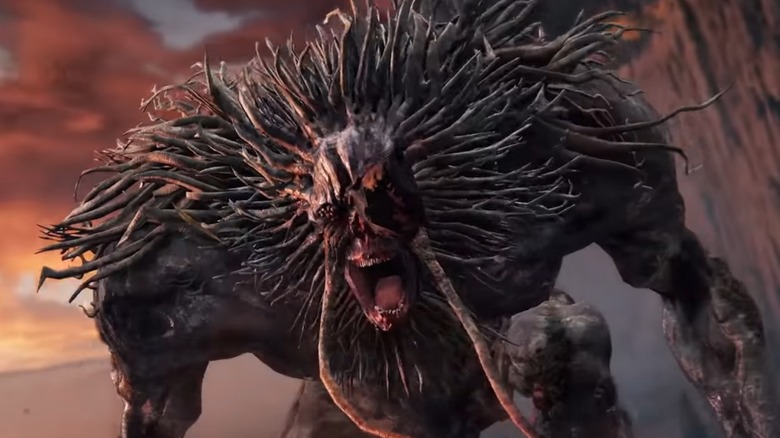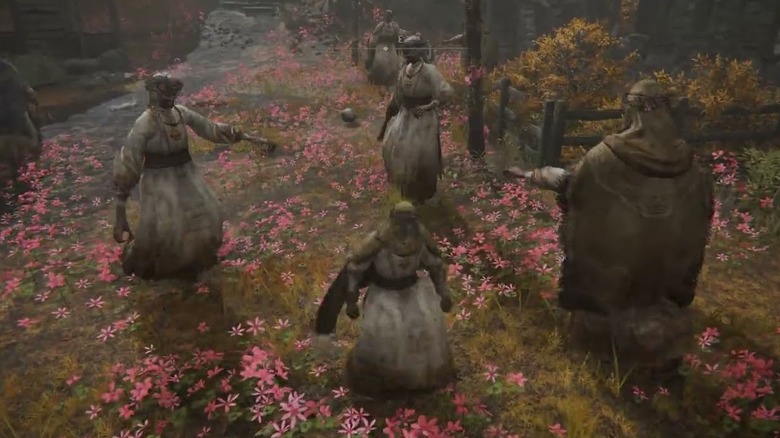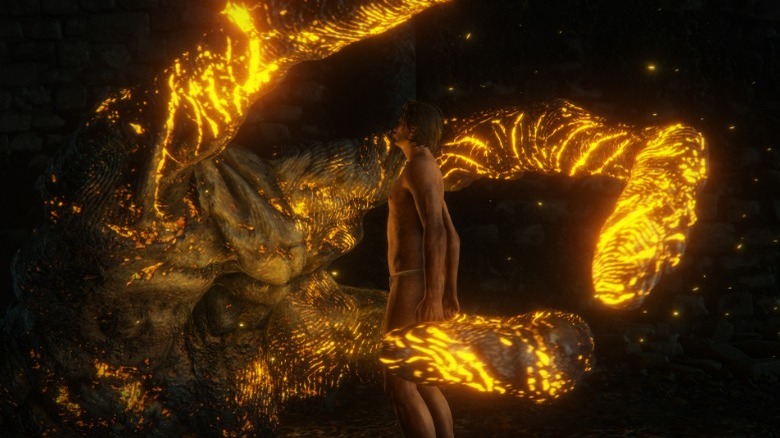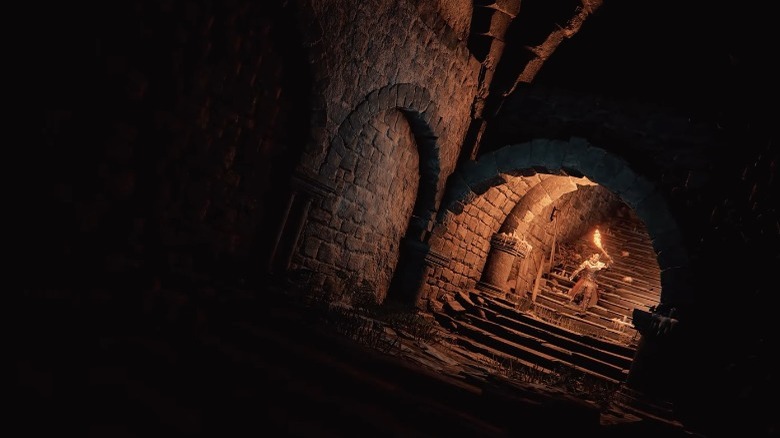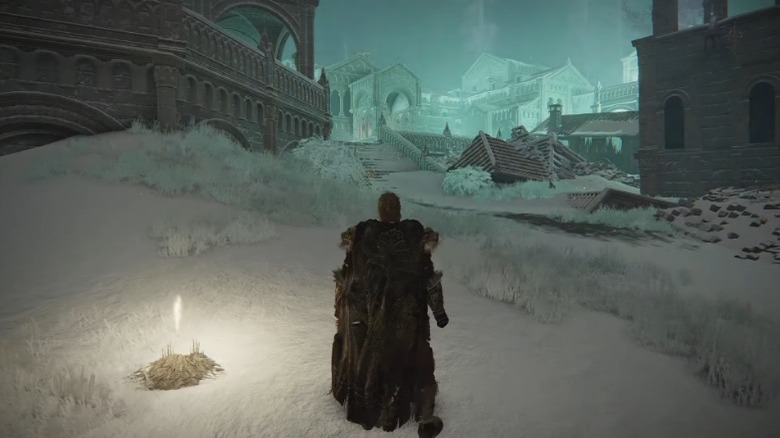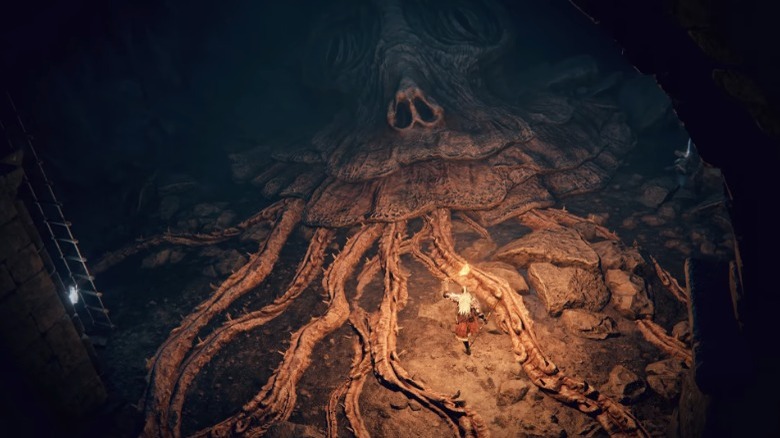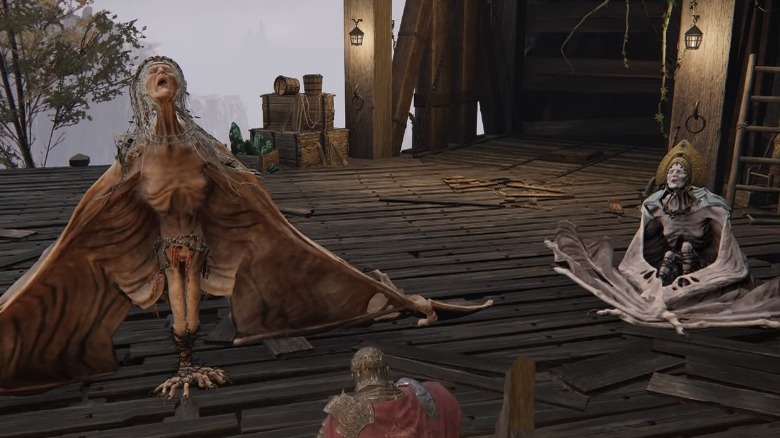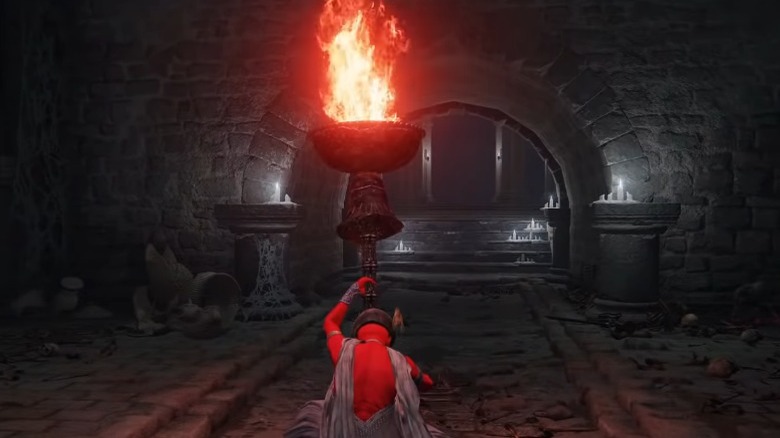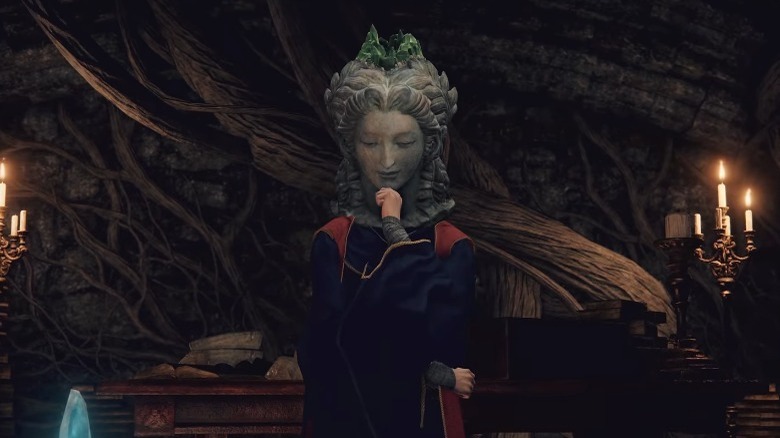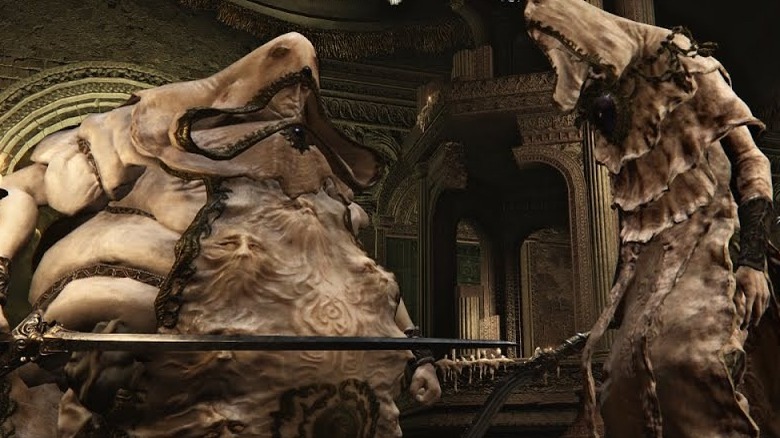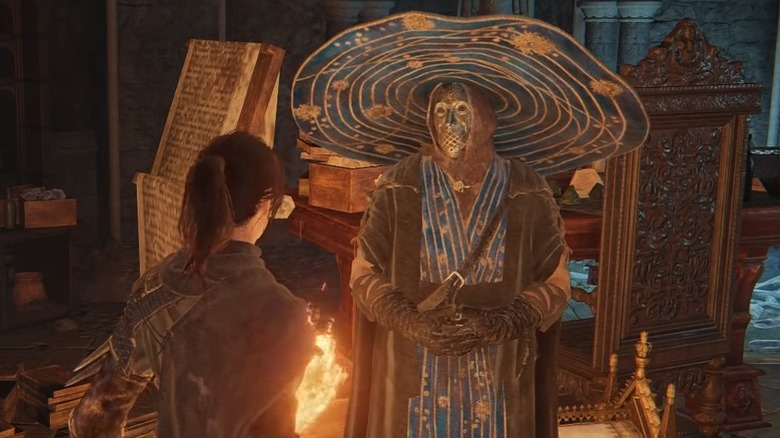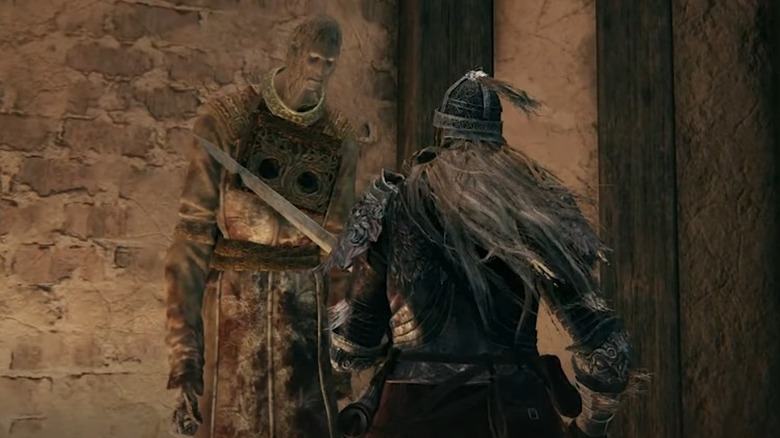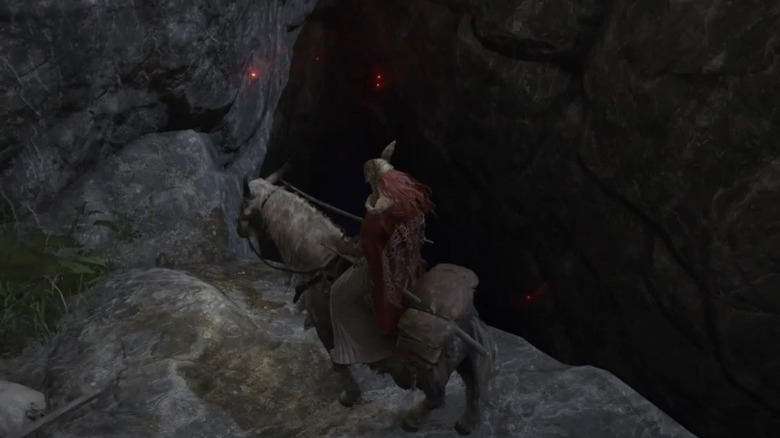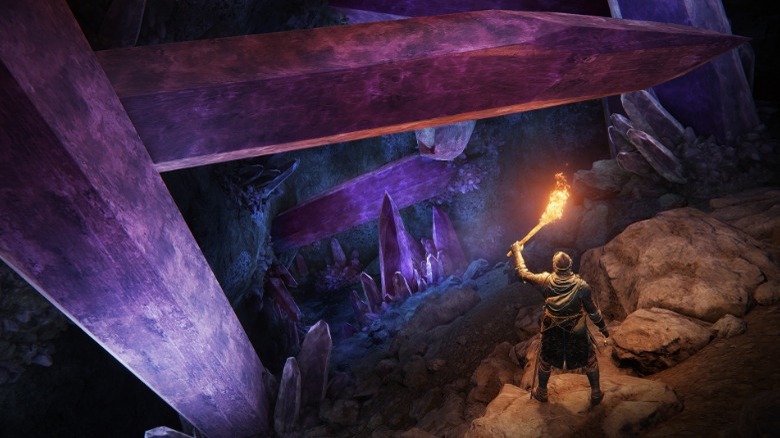The Creepiest Things Found In Elden Ring
The Lands Between is not a good place to live. Sure, the Erdtree makes for a nice, scenic view, but you have to constantly worry about being robbed by bandits, eaten by wolves, or having your limbs torn off and grafted onto a giant king. And that's just the regular, mundane threats.
The world of "Elden Ring" is full of creepy lore and locations. Players will inevitably bump into some truly terrifying creatures, such as the spider-like Grafted Scions and whatever the heck Wormfaces are supposed to be. But, even the scariest of giant, ambulatory hands and malformed musicians have nothing on the game's creepy locations and bits of lore. From towns of cannibals to hammers made of faces, "Elden Ring" demonstrates that sometimes the scariest parts of a video game aren't always the monsters that jump out from behind a corner and start snacking on your face.
Here are the creepiest things we've found in "Elden Ring" so far. Beware of spoilers ahead for "Elden Ring."
The Dancing Ladies of Dominula, Windmill Village
Most towns in "Elden Ring" are unwelcoming to Tarnished strangers. Locals tend to attack players on sight, so it's natural to expect the worst. However, sometimes the only thing worse than a hostile townsperson is a seemingly benign one.
Dominula, Windmill Village looks like any other hovel in the Lands Between. However, whenever players first visit the town, instead of being greeted by pitchforks and knives, they're welcomed by women preoccupied with dancing. This otherwise friendly sight is immediately soured by the appearance of these women, who are all inhumanly gaunt and gangly. Plus, they cackle like witches, and on closer inspection, their clothes are ratty and bloodstained.
The deeper players dive into Dominula, the creepier things get. If the women are attacked or otherwise disturbed, they turn on the player and wield weapons that, according to their descriptions, are fashioned from human bone. And if that's not enough, sometimes these crazed celebrants bite into their own wrists and spew blood at players — no other enemies in "Elden Ring" have this disturbing attack.
What made these ladies so bloodthirsty? Nobody knows for certain, but the internet has its theories (more on that later). The only thing fans know for sure is that nearby spirits claim these dancers skin victims alive, which is almost as disturbing as their dancing.
Frenzied Flame Village and its Connection to the Merchants
The Frenzied Flame Village is arguably one of the most dangerous towns in the Lands Between — if players aren't careful, the town can kill them before they even reach it. The village is home to the titular Frenzied Flame, which sits atop a tower like the Eye of Sauron and builds up Madness. This mechanic puts players on edge (and gives "Bloodborne" veterans Brain of Mensis flashbacks), and even when gamers reach the town, things don't get better. Enemies and loot in the village proper tie into themes of frenzy, which steeps the area in mystery. However, the village is only the tip of the iceberg.
If players find a hidden note, they are eventually led to the Frenzied Flame Proscription. Inside, players will find floors covered in the corpses of what appear to be Nomadic Merchants. Gamers can even loot Nomadic Merchant equipment, which plainly states the Merchants were accused of heresy, buried alive in the Proscription, and summoned the Frenzied Flame in revenge. But don't take a flavor text's word for it; when attacked, Nomadic Merchants defend themselves with Frenzied Flame Incantations.
This connection raises even creepier implications. Did the Nomadic Merchants worship the Frenzied Flame before their imprisonment? If not, did the forces of the Lands Between unwittingly turn them into heretics? Did the Merchants target the village or was it just a random victim? It's enough to drive someone mad.
Leyndell Catacombs
Most catacombs in "Elden Ring" are creepy enough thanks to their enemies, traps, and floors littered with skeletons. Despite the crumbling walls, catacombs usually provide a sense of progression and let players know when they're on the right path. Leyndell Catacombs, however, messes with gamer's minds.
Leyndell Catacombs is somewhat maze-like, and players have to solve easy puzzles to progress. Once they do, players will encounter some familiar sights. Rooms seemingly repeat, just with minor alterations. (Was that torch always lit? There wasn't an ogre in this room the last time you visited, was there?) The result makes players feel quite uneasy, because the brain says they should be progressing, but their eyes say they aren't. This is the same trick "P.T." used to freak players out.
No other dungeon in "Elden Ring" uses the ruse of repeating rooms, so it catches players off guard and freaks them out. Moreover, Leyndell Catacombs' design raises an important question: What is the in-game explanation? Did the catacombs' designer get lazy, or did they intentionally repeat rooms to trick would-be graverobbers and make them lose their minds? Is the Leyndell Catacombs under some sort of curse? The lack of an explanation is almost as creepy as the layout.
Ordina Liturgical Town
The Lands Between is dotted with evergaols, which players can enter to fight powerful enemies in small pocket dimension arenas. However, one evergaol acts completely differently, which gives it an extra creepy vibe.
Unlike most villages in "Elden Ring," Ordina Liturgical Town is deserted. No NPCs, just uncomfortable silence. Eventually, players find the town's evergaol, which hides a puzzle needed to acquire the Black Knife armor set. However, upon entering the evergaol, players can't help but feel that they're being watched. Maybe it's the solid black sky, or maybe it's what sounds like footsteps in the distance. Or maybe it's the invisible Black Knife assassin, who constantly stalks players to backstab them.
Ordina Liturgical Town's evergaol provides a whole new sense of paranoia, because gamers who want to earn this armor need to brave an unnatural location that puts them on edge, thanks in no small part to its tangible threat. How do you avoid what you cannot see or hear? You can swing wildly, hoping to connect, or you can buy a Sentry Torch, which reveals the Black Knife assassin. Then again, "Elden Ring" doesn't exactly feature invisible enemies outside of Ordina Liturgical Town's evergaol, so unless players know exactly what to expect before they arrive, odds are good that the evergaol will continue to terrify them.
Godwyn's corpse under Stormveil Castle
The assassination of Godwyn the Golden essentially kicked off the events of "Elden Ring." His death ultimately resulted in the Elden Ring being shattered, the remaining demigods engaging in a civil war, and the Tarnished returning to the Lands Between. Since Godwyn was the firstborn son of the lands' queen/god Marika the Eternal, one might assume he was buried in a place of honor. He was – but that wasn't the end for his corpse.
If players delve into the depths of Stormveil Castle, they will eventually find a giant, misshapen face that looks like an octopus as drawn by Junji Ito. The un-interactive map asset is disturbing on its own, but it only gets worse the more players uncover its mysteries. A nearby lootable item, Prince of Death's Pustule, implies that the face is Godwyn's, deformed beyond recognition. But if that's true, what is it doing in Stormveil when the item says it should be under Leyndell, Royal Capital? Retrieving the Cursemark of Death and completing Fia's quest will reveal a horrible truth: Godwyn only died in spirit. His body lived on, mutated horribly, and spread throughout the Lands Between like a cancer, traveling down the Erdtree's roots. That's not all Godwyn's soulless body-turned-tumor did, though.
As players explore Stormveil Castle, they will probably notice holes scattered throughout the dungeon. These don't look like they were the result of an attack, but more like something is eating away at the castle. According to the Marred Leather Shield, this could be the result of a curse brought on by Godrick the Grafted's machinations. Or more likely, Godwyn's "death" turned his body into a force of pure destruction that rots everything it touches.
Singing Bats
"Elden Ring" is full of scary locations, so it's only fitting the game would also house scary enemies. You don't have to search far to find a creepy creature out for blood, but one of the creepiest is actually somewhat benign. Or maybe she's just too engaged in the pastime that generates her creep factor.
Some of the first enemies players will find in the open world of "Elden Ring" are the Giant Bats. These creatures are disturbing in their own right due to their size, but if someone wanders the Lands Between and hears singing in the distance, that means the far creepier (and possibly related) Singing Bat or Chanting Winged Dame is nearby. Both of these creatures are similar in appearance, as they have bat-like bodies with the head of an old crone. This cursed combination is nothing new to FromSoftware — some crows in "Bloodborne" have dog heads, after all. However, what makes the Singing Bats and Chanting Winged Dames so creepy are the songs that give them their names.
These women-headed bats utter a tune that is beautifully haunting. The song is in Latin, and when translated provides a quick rundown of the Lands Between. Singing Bats and Chanting Winged Dames sing of how the world has become cursed and robbed of its destiny, and that nobody has been able to help. These creatures are usually passive and only respond to players when attacked — they would rather deal emotional damage with their dirges than poison damage with their breath. However, that raises the question of where these monsters came from and how they know so much about the Lands Between's history.
Cranial Vessel Candlestand
"Elden Ring" is full of crazy weapons. Players can find a whip made out of braided fire giant's hair, a hammer crafted from magical ferrofluid, and a giant sword made out of smaller swords. However, most weapons are weirder than they are creepy — with one notable exception.
The Cranial Vessel Candlestand, true to its name, is a warhammer formed from a Prelate's helmet, which has been skewered onto a sharp spike to create a makeshift candlestand. However, the item description claims the weapon's origin is a bit more disturbing. According to the flavor text, the Cranial Vessel Candlestand is a relic created by the ancient Prelate Birac, who was so angry over the laziness of his fellow monks that he decapitated himself. That's... certainly a creepy way to teach people a lesson.
To Birac's credit, though, his unnecessary sacrifice worked. His fellow Prelates started doing their duties and even shoved his head on a pike to worship him. And even though Birac died, his faith is still strong enough to summon fountains of fire out the top of his candlestand-mounted head.
The Cranial Vessel Candlestand's origin elevates it far above any other weapon in "Elden Ring" in terms of creep factor. Other weapons simply don't measure up. Necromancer Garris' Family Heads is just a flail with weaponized copper weights designed to look like his wife and children — still not quite as creepy as actually using someone's head. The Ringed Finger is the only weapon that comes close, but let's be honest here: Wielding the severed finger of one of the game's most annoying enemies is more cathartic than creepy.
Sorceress Sellen
FromSoftware games are crawling with body horror. Players can't walk five steps without encountering angry pillars made of skeletons, zombies controlled by maggots, and snail women. However, all of those enemies became malformed long before the events of their respective games. In "Elden Ring," though, players are responsible for the mutation of one particularly unfortunate (and helpful) soul.
Sorceress Sellen starts off like many NPCs in "Elden Ring." Players can summon her to help fight several bosses, buy items from her (primarily Glintstone Sorceries), and complete her quest to earn several powerful rewards. At first glance, Sellen doesn't look creepy at all. Sure, she wears a giant stone mask that encompasses her entire head, but that's more weird than disturbing. In fact, nothing downright creepy is associated with Sellen until the end of her questline.
Before players complete Sorceress Sellen's mission, they are given a choice: Side with Witch-Hunter Jerren and kill Sellen, or ally with Sellen to kill Jerren. If players kill Sellen, they are honestly doing her a favor, because if gamers instead kill Jerren, Sellen will thank her allies with a new spell. Sounds pretty great, all things considered, so you may be wondering why death is preferable.
Well, if players leave and then re-enter of reload the area, they will find that Sellen has transformed into a gigantic sphere of stone faces, nearly identical to a School of Graven Mages (or Arcane Sphere of Faces). Oh, and she is in horrible agony. Nobody knows exactly how she turned into the sphere – Graven-School and Graven-Mass talismans offer some hints, but no solid answers.
If players help Sorceress Sellen, they will understand the meaning of the phrase "no good deed goes unpunished" — and it's all their fault.
Everything Godskin
Even though virtually everything is out to get you in "Elden Ring," the game still has various factions, each with their own histories, goals, and unique enemies. One of the most disturbing is the Godskins, who are even more disgusting than it sounds.
Godskins menace players' minds from the very first encounter. These enemies come in two flavors: Godskin Nobles and Godskin Apostles. Nobles are rotund abominations who can inflate their bodies and roll around like flabby boulders, while Apostles are thinner and can stretch their torsos like humanoid earthworms. However, this body horror is just the tip of the fleshy Godskin iceberg.
If players look carefully, they might notice that Godskins wear what appears to be skin, and that is exactly what they do. Godskin armor flavor text confirms that these disturbing enemies wear nothing but the skin of their victims; even the swaddling "cloths" used to wrap their newborns are made of skin. Moreover, Godskin weapons are designed for peeling skin. However, even when Godskins aren't flaying their victims, their influence is still felt throughout "Elden Ring." The Albinauric Mask's in-game explanation states it was inspired by the Godskins — and designed to mock them. And if players explore Dominula, Windmill Village, they will find a Godskin Apostle hanging around the outskirts near its titular windmills. What is one of them doing near this village of crazed women? The running theory is that Godskins are responsible for corrupting its inhabitants, a belief backed up by nearby spirits who claim the women skin people.
Normally, we'd recommend staying away from the Godskins, but some are mandatory boss battles.
Preceptor Seluvis
Like many worlds created by FromSoftware, the Lands Between is trapped in a downward spiral with seemingly no hope in sight. The countryside is full of creatures that care not for their victims' morality, so why bother holding onto it? Sometimes the mind of a man who lost all scruples is more monstrous than the zombies he surrounds himself with. Initially, Preceptor Seluvis seems nice. He just wants players to give the NPC Nepheli Loux a potion. Seems harmless, so long as you don't dig into the potion, Seluvis' motives, or Seluvis himself.
If players do a bit of exploring, they can find Seluvis' secret laboratory, filled with inanimate NPCs. Turns out Seluvis has a disturbing obsession with turning people into "puppets" — mindless husks with no will of their own, rather than the far less creepy (and more literal) Marionette Soldiers.
How does Seluvis do it? With the potion he wanted players to give Nepheli Loux. Depending on how much players help Preceptor Seluvis in his mad schemes, he will offer several of his puppets as Spirit Ashes– for a price, of course. But you know what's even more terrifying than Preceptor Seluvis' obsession with turning people into mindless slaves? He's not alone in it. Pidia, Carian Servant is another NPC who deals in "puppets," although he's more concerned with the maintenance than the actual transformation.
While Preceptor Seluvis is admittedly demented, he's not all bad. If players take advantage of his services and quest, they can turn the Dung Eater, the Lands Between's own curse/poop-themed Jack the Ripper, into a puppet. Given his long list of atrocities, that's honestly a better use of his skills than leaving him to his own devices.
Gatekeeper Gostoc
Patches, the most untrustworthy character to ever bear the nickname "Trusty," is a soulsborne legend. The man has appeared in almost every FromSoftware title since "Armored Core: For Answer," and is always a lowdown coward who ambushes potential victims and grovels when beaten. Usually, Patches is a one-of-a-kind NPC, but in "Elden Ring," he isn't the only craven thief.
Early in "Elden Ring," right before players enter Stormveil Castle, they can meet Gatekeeper Gostoc. At first he seems trustworthy enough, as his advice actually helps players — true to his word, storming the front gate is a horrible idea. But the further audiences advance into the castle, the more they will notice Gostoc hiding in areas they just passed, almost as if he's stalking them. Because he is.
Whenever players die in Stormveil Castle, they lose Runes. That don't mean they just drop Runes; that goes without saying in any "Soulsborne" game. But whenever a player retrieves their Runes in the castle, they will only find 70% of what they originally had — because Gostoc pocketed the missing 30%. This is backed up by the sight of him looting the occasional corpse in the castle.
What makes Gostoc truly creepy isn't a demented dream or a form dripping with body horror. Unlike Patches, Gostoc obviously knows what he's doing. He stays out of sight, and players never know he's there unless he announces his presence. Gostoc robs players blind. Creepiest of all, though: he actually gets away with it.
Screaming in Limgrave
"Soulsborne" titles shy away from exposition. Instead, they rely on item flavor text and environmental storytelling to provide a narrative, or at the very least backstory. Given the grimdark nature of "Elden Ring," this primarily means bodies; lots and lots of bodies. Most of these are cadaverous set dressing that tell a story, but some aren't as dead as they'd like.
If players explore Limgrave, they will eventually find a giant pit. What makes this pit "special" is that if players visit it at night, they can hear blood-curdling screams seemingly emanating from it. These screams are downright chilling since they are clearly from something in unending pain. Plus, the sounds are bound to catch players off guard, which adds to the creep factor.
But what is causing the screams? Even though many gamers have tried to plumb the hole's depths and have fallen to their deaths as a result, most are convinced it is coming from something deep inside it. Others, however, believe the screaming emanates from the countless crucified bodies hanging around Limgrave. Why they only scream at night is anyone's guess, but it's still creepy regardless.
Glintstone
Ever since "Bloodborne," FromSoftware has been associated with games that initially provide a fantasy setting, either medieval or Victorian, and then sneak in some Lovecraftian horror. "Elden Ring" continues that tradition with its various Outer Gods, but one of the most insidious otherworldly forces in the game is a common magic catalyst. A little too common, actually.
One of the most prevalent spell types in "Elden Ring" is Glintstone Sorceries. They are the bread and butter of any Intelligence-focused player, as the Astrologer and Prisoner classes start with these spells. Plus, you can't cast any Sorcery, regardless of type, without a Glintstone Staff of some kind. Thankfully, Glintstone grows in abundance, so sorcerers in-game don't have to worry about running out anytime soon. They do, however, have to worry about Glintstone replacing everything in their bodies, including their souls.
In truth, Glintstone is not native to the Lands Between; it's an alien, invasive crystal that turns everything around it into more Glintstone, which is why it's so common. The material has crystallized plants throughout Liurnia of the Lakes, as well as the people who mine it. Glintstone Dragon Smarag is infested with the crystals because it ate so many sorcerers who wielded Glintstone items, and Masters Lusat and Azur used so much Glintstone that it replaced their skulls and brains.
A popular theory is that the Erdtree is a parasite, and whether or not that is true, Glintstone definitely seems to be a parasite. Ironically, some of the most powerful builds in "Elden Ring" rely on Glintstone items and spells. Nothing worse than a parasite that makes its victims dependent on it.

